
THE LAST UNICORN REVIEW
Peter S. Beagle’s novel The Last Unicorn begins with words as legendary as Tolkien’s The Hobbit: “The unicorn lived in a lilac wood, and she lived all alone.” Thus, he introduces his deceptively simple tale about an immortal unicorn who realizes that it has been many years since she has seen other unicorns. There was a time when unicorns were abundant in the world. Where are the others?
RELATED Vintage Review: Daughter of The Empire
The answer appears in the form of a butterfly, a playful, half-mad creature who, like all butterflies, repeats bits and scraps of information it’s heard on its travels. At first, it doesn’t have much of use to tell the unicorn then suddenly she learns what happened to the others in stark, chilling language: “No, no, listen. Don’t listen to me, listen. You can find your people if you are brave. They passed down all the roads long ago, and the Red Bull ran close behind them and covered their footprints.”
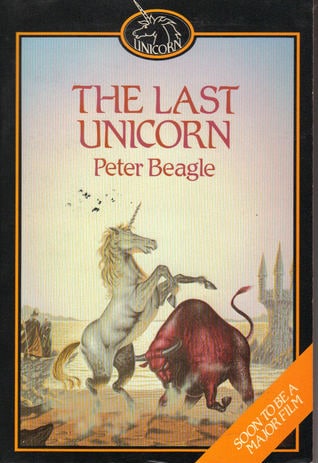 What is the Red Bull? From Beagle’s descriptions, we know that it is a creature from everyone’s deepest nightmares.
What is the Red Bull? From Beagle’s descriptions, we know that it is a creature from everyone’s deepest nightmares.
And the classic fantasy quest begins, though, at the same time, this is a journey unlike any you’ve seen in other books. Although she knows that without her, winter will come to her enchanted forest, the unicorn realizes she must go and find the others and bring unicorns back into the world. She sets out despite the dangers and uncertainties that lurk outside her home.
Along the way, she experiences adventures that she could never have imagined, and of course, she meets enemies and friends. She comes across the magician Schmendrick with his ageless face. He is quite powerful, but many of his spells don’t work quite the way he wants them to. They eventually meet Molly Grue, who is worn by the cares of her life and devastated when she first sees the unicorn.
“And what good is it to me that you’re here now? Where were you twenty years ago, ten years ago? How dare you, how dare you come to me now, when I am this?” With a flap of her hand she summed herself up: barren face, desert eyes, and yellowing heart. “I wish you had never come. Why did you come now?” The tears began to slide down the sides of her nose.
Molly forgives the unicorn, though. Of course, she must. They continue searching for the others and come to the kingdom of King Haggard, who is as perfectly named as a king can be, and his son Prince Lir who is destined for greatness and heartbreak. As Schmendrick says, “Great heroes need great sorrows and burdens, or half their greatness goes unnoticed. It is all part of the fairy tale.”
The Last Unicorn is an indispensable story for anyone who loves fantasy. Beagle has created a story which pulls at your heart as it sometimes reminds you of the inevitable sadness of our world because it changes and is 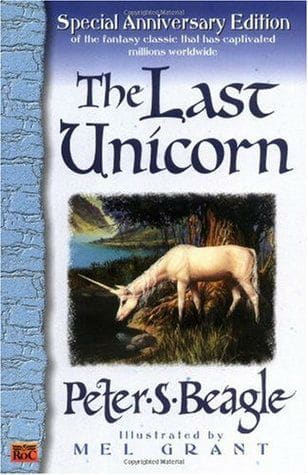 always changing. Nothing can ever stay the same, not even unicorns, but there is always hope because at least there is one unicorn still left in the world. Her determination and bravery is both heart-wrenching and uplifting, and like all the characters in the story, the reader is awed by her and what she represents.
always changing. Nothing can ever stay the same, not even unicorns, but there is always hope because at least there is one unicorn still left in the world. Her determination and bravery is both heart-wrenching and uplifting, and like all the characters in the story, the reader is awed by her and what she represents.
Peter S. Beagle writes in an effortless, exquisite language that I envy. You feel that you are reading a legend as you are drawn into the tale; yet at the same time, the story sometimes prods and amuses us with quirky or practical details:
‘”What have you heard of dashing Captain Cully and his band of freemen?'” thunders the leader of some thieves they meet in the wood, but then he adds, “‘Have a taco.'” When the travelers encounter possible trouble, “The magician stood erect, menacing the attackers with demons, metamorphoses, paralyzing ailments, and secret judo holds. Molly picked up a rock.”
Beagle’s tale may appear to be the typical quest story, but it’s full of the unexpected and of contradictions while at the same time employing well-known fantasy elements. So, for example, there is a powerful king, a hero in waiting and a magician incorporated into this story, but the unicorn is the heroine of this tale, not a passing element of the story. There is no beautiful maiden, at least not at first, just plain, old Molly Grue who cooks and cleans and should have passed her time for unicorns long ago. King Haggard’s castle is imposing, gloomy and mysterious, but one of the inhabitants 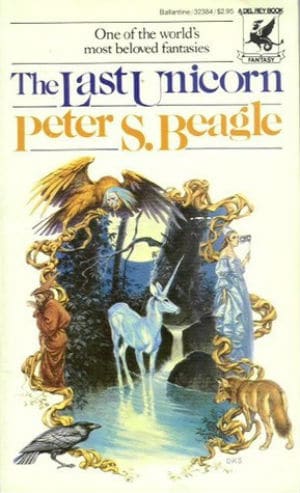 who is most important to the story is a one-eyed cat who of course knows all the secrets, but explains, “I am what I am. I would tell you what you want to know if I could, for you have been kind to me. But I am a cat, and no cat anywhere ever gave anyone a straight answer.”
who is most important to the story is a one-eyed cat who of course knows all the secrets, but explains, “I am what I am. I would tell you what you want to know if I could, for you have been kind to me. But I am a cat, and no cat anywhere ever gave anyone a straight answer.”
Even if you don’t (inexplicably) love fantasy, I’d recommend giving this book a try as in many ways, it is not your typical fantasy novel at all. You can pick it up for the unusual, absorbing standalone story or just to drink in Beagle’s astonishing prose. I guarantee there will be some quotes that will stick with you long after you’ve read it, just as the unicorn herself will haunt you and stay with you, much as she does with the other characters of the story.
If you’ve been introduced to this tale through the very good 1982 animated movie, I think you will find even more to enjoy reading the book. The movie follows the book very faithfully, but there are many more wonderful details in the story, and it is easier to appreciate the superb language.
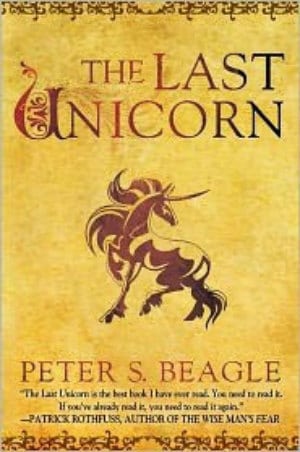
I wondered as I wrote this if I should classify The Last Unicorn as YA. It is definitely appropriate for readers in that category, but like most classics, I think it can be read and enjoyed by anyone of any age. Even if like Molly, the unicorn comes to you when you are no longer new, it’s never too late to meet her.
Have you read The Last Unicorn? What are your thoughts on this classic story?
OVERALL RATING
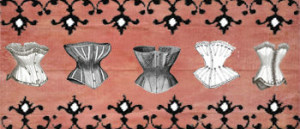
“The stuff that dreams are made of.”
ROMANCE RATING

“Happiness in marriage is entirely a
matter of chance.”
ARE YOU A ROMANCE FAN? FOLLOW THE SILVER PETTICOAT REVIEW:
 Our romance-themed entertainment site is on a mission to help you find the best period dramas, romance movies, TV shows, and books. Other topics include Jane Austen, Classic Hollywood, TV Couples, Fairy Tales, Romantic Living, Romanticism, and more. We’re damsels not in distress fighting for the all-new optimistic Romantic Revolution. Join us and subscribe. For more information, see our About, Old-Fashioned Romance 101, Modern Romanticism 101, and Romantic Living 101.
Our romance-themed entertainment site is on a mission to help you find the best period dramas, romance movies, TV shows, and books. Other topics include Jane Austen, Classic Hollywood, TV Couples, Fairy Tales, Romantic Living, Romanticism, and more. We’re damsels not in distress fighting for the all-new optimistic Romantic Revolution. Join us and subscribe. For more information, see our About, Old-Fashioned Romance 101, Modern Romanticism 101, and Romantic Living 101.

Well, my opinion of the Last Unicorn is that it’s your typical Freemason/Scythian book filled with problems which contradict both science and faith in God. I think it could have had the potential to be an entertaining story for children, but the pervert-ness of Peter S. Beagle prevented it from being so.
First of all, unicorns are not mythical creatures. They are real. They were and are not a mythical horse-like creatures with mythical powers; nor are they an extinct species of equines with horns on their heads.
In the Ancient world, unicorns were never thought of as being my mythical creatures. Unicorns are a scientific anomaly which occur among Atriodactyls such as goats and deer. Some deer and goats are born with one horn on the center of their head, such as the deer Unicorno, who was discovered by Italian zoologists in the forests of Tuscany in 2005. He was very elusive, and difficult to capture. What’s odd about Unicorno, is that you would think coming from a species of deer with antlers, that he would have on antler. However, no, he has one horn in the center of his head. In 2009, a farmer had claimed that he had bread a Unicorn goat, which looked exactly like how unicorns are described in tapestries from the 14th-15th centuries A.D.. The horn was not a spiraling horn, but it looked long enough that it could have done the same damage that the unicorn did to the fiery bull in the novel. Could this have been a species of one-horned goat to itself? The video was on Youtube, but it was taken off. There are other videos of real unicorns, but not as incredible as that one.
According to Herodotus, he once saw a herd of Unicorns in Ancient Greece, which leads me to two conclusions. One, that this could have been a much more common phenomenon in the Ancient world than today, or two that there could have been a species of one horned goat that went extinct.
Of course, this is not the first account of Unicorns. In the Holy Scriptures, there are historical references to Unicorns. I believe, that this was an anomaly in the Ancient World, that was considered to be glorious and a precious occurrence among creatures created by God Almighty The Holy Trinity.
Roman and Byzantine mosaics depicting unicorns, depict Unicorns as being completely goat-like animals. Nothing horse-like about them like in the Last Unicorn. Even in depictions from the 600s-1200s A.D., unicorns are either depicted as looking like deer or goats instead of horses. Even their size indicates it. Also, during from the fifth century A.D.-fourteenth century A.D., when there were the forefathers of learning and knowledge such as Dunus Scotus, Alexander Hales, Herman the Cripple, and St. Isidore the Visigoth (all of whom came from the peasantry), mythical powers were never attributed to Unicorns. They expanded upon the works of the forefathers of learning and knowledge of the Ancient Greeks and the Romans.
So why and how do we think of Unicorns as being horse-like animals with mythical powers?
Well, during the 14th-15th centuries A.D., as the Kingdom of Scotland and Kingdom of England were discussing unification (which would not happen until the glorious days of the Stewart Dynasty, when kings of Scottish descent ruled the United Kingdom justly and fairly), artists began creating tapestries depicting virgins with lions and unicorns. The virgin represents the Holy Theotokos (The Virgin Mary who prays to God for Great Britain), the Unicorn represents Scotland, the Lion represents England (as it had been since the reign of King Alfred the Great).
Back then, goats were thought of in the Biblical sense as being metaphors of disobedience and sinful nature in regards to the Apocalypse. A horse was considered an incredible animal. Artists began taking poetic and artistic license, and depicted Unicorns as having horse like heads, yet in everything else they look like a goat even in size. They also began depicting Unicorns as having spiraling horns, which was again artistic license. This became a very beloved way to depict Unicorns, even the German artists began to depict the Einhorn that way with the horse like head. Yet, no mythical powers were attributed to the creature.
The first time we start hearing accounts of Unicorns being mythical creatures with supernatural powers is during the Renaissance. The myth of the fabled horse-like Unicorn, is that Unicorns were horned-equines whose powers had the abilities to protect the creatures of the forests, and heal people. Unicorns did not like people, but were attracted to virgins. However, when the virgins grew up, got married, and had children (which is sanctified by God just as much as monasticism is) when they tried to pet the Unicorn, the Unicorn would run away from them.
This legend is depicted in the Pagan-Revival Age painting The gentle and pensive maiden has the power to tame the unicorn by Domenichino, painted in the 1600s.
In one of his notebooks Leonardo da Vinci wrote:
The unicorn, through its intemperance and not knowing how to control itself, for the love it bears to fair maidens forgets its ferocity and wildness; and laying aside all fear it will go up to a seated damsel and go to sleep in her lap, and thus the hunters take it.
So anyways, Beagle could have made a creative novel if he had wrote about a real unicorn (perhaps a species of one-horned goat) that lived during what people call the Medieval Ages. A story filled with beautiful princesses, heroic princes, and knights at war with Vikings. Perhaps with a fiery bull.
Although, a fiery bull is nothing new. Actually, the fiery bull comes from Etruscan Mythology with the story of Hercules and the fire breathing bull.
As for my criticism of the rest of the stupid book, it promotes beasteality (with the Unicorn-human love story from Sodom and Gomorrah), and blasphemously mocks the power of Our Lord Jesus Christ Almighty, Who Is Risen, by saying the Unicorn could resurrect people from the dead. Aside from that, he copies less than Tolkien, but still steals from other legends.
I think it’s a stupid book!